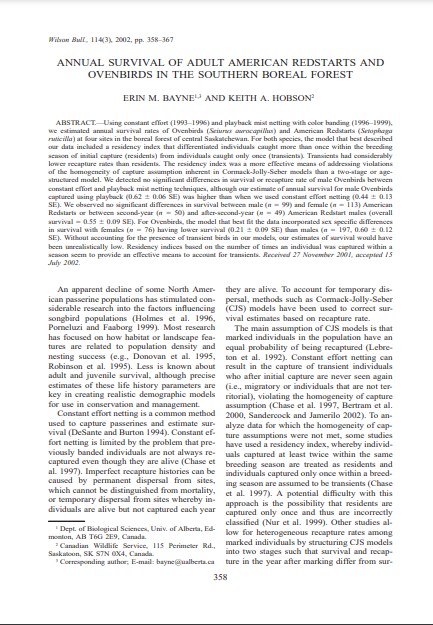Annual Survival of Adult American Redstarts and Ovenbirds in the Southern Boreal Forest
Bosque Modelo:
Prince Albert
Temática:
Conservación
Tipo de documento:
Artículo científico
Resumen
Using constant effort (1993–1996) and playback mist netting with color banding (1996–1999), we estimated annual survival rates of Ovenbirds (Seiurus aurocapillus) and American Redstarts (Setophaga ruticilla) at four sites in the boreal forest of central Saskatchewan. For both species, the model that best described our data included a residency index that differentiated individuals caught more than once within the breeding season of initial capture (residents) from individuals caught only once (transients). Transients had considerably lower recapture rates than residents. The residency index was a more effective means of addressing violations of the homogeneity of capture assumption inherent in Cormack-Jolly-Seber models than a two-stage or agestructured model. We detected no significant differences in survival or recapture rate of male Ovenbirds between constant effort and playback mist netting techniques, although our estimate of annual survival for male Ovenbirds captured using playback (0.62 6 0.06 SE) was higher than when we used constant effort netting (0.44 6 0.13 SE). We observed no significant differences in survival between male (n 5 99) and female (n 5 113) American Redstarts or between second-year (n 5 50) and after-second-year (n 5 49) American Redstart males (overall survival 5 0.55 6 0.09 SE). For Ovenbirds, the model that best fit the data incorporated sex specific differences in survival with females (n 5 76) having lower survival (0.21 6 0.09 SE) than males (n 5 197, 0.60 6 0.12 SE). Without accounting for the presence of transient birds in our models, our estimates of survival would have been unrealistically low. Residency indices based on the number of times an individual was captured within a season seem to provide an effective means to account for transients
Información Bibliográfica
Autor:
Bayne, EM and KE Hobson.
Revista:
The Wilson Bulletin
Año:
2002
N°:
3
País :
Canadá
Páginas:
358 - 367
Volumen:
114
Idioma:
Ingles
Palabras claves
Model forest, Adaptatation, Canada





